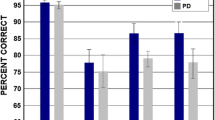Abstract
Despite the important role of taste function in nutrition and health, little is known about changes in taste function caused by Parkinson disease (PD). The taste function of 31 PD patients and 29 healthy controls was assessed quantitatively using filter paper taste strip tests (TSTs) impregnated with four basic taste qualities at four different concentrations. The mean TST score was significantly lower in PD patients, as a consequence of taste impairment in the female PD patients (it did not differ significantly in males), which was likely to be attributable to the lower Mini-Mental State Examination score in patients with PD than in controls in women. TST scores in PD patients were not correlated with patient age, duration, or severity of their PD, or olfactory function. The findings of our study suggest that taste dysfunction should be included in the list of nonmotor symptoms of PD.

Similar content being viewed by others
References
Heckmann JG, Heckmann SM, Lang CJG, Hummel T (2003) Neurological aspects of taste disorders. Arch Neurol 60:667–671
Woschnagg H, Stollberger C, Finsterer J (2002) Loss of taste is loss of weight. Lancet 359:891
Doty RL (2007) Olfaction in Parkinson’s disease. Parkinsonism Relat Disord 13:S225–S228
Chaudhuri KR, Martinez-Martin P, Schapira AH et al (2006) International multicenter pilot study of the first comprehensive self-completed nonmotor symptoms questionnaire for Parkinson’s disease: the NMSQuest study. Mov Disord 21:916–923
Lang CJG, Leuschner T, Ulrich K, Stoßel C, Heckmann JG, Hummel T (2006) Taste in dementing diseases and parkinsonism. J Neurol Sci 248:177–184
Shah M, Deeb J, Fernando M et al (2009) Abnormality of taste and smell in Parkinson’s disease. Parkinsonism Relat Disord 15:232–237
Sienkiewicz-Jarosz H, Scinska A, Kuran W et al (2005) Taste responses in patients with Parkinson’s disease. J Neurol Neurosurg Psychiatry 76:40–46
Hughes AJ, Daniel SE, Kilford L, Lees AJ (1992) Accuracy of clinical diagnosis of idiopathic Parkinson’s disease: a clinico-pathological study of 100 cases. J Neurol Neurosurg Psychiatry 55:181–184
Kim HJ, Lee DH, Cho JY, Cho YJ, Hong KS (2010) Taste sense in patients with hemifacial spasm. J Clin Neurosci 17:950–951
Landis BN, Welge-Luessen A, Bramerson A et al (2009) “Taste Strips” a rapid, lateralized, gustatory bedside identification test based on impregnated filter papers. J Neurol 256:242–248
Doty RL, Marcus A, Lee WW (1996) Development of the 12-item cross-cultural smell identification test (CC-SIT). Laryngoscope 106:353–356
Lee JY, Lee DW, Cho S-J et al (2008) Brief screening for mild cognitive impairment in elderly outpatient clinic: validation of the korean version of the montreal cognitive assessment. J Geriatr Psychiatry Neurol 21:104–110
Hoops S, Nazem S, Siderowf AD et al (2009) Validity of the MoCA and MMSE in the detection of MCI and dementia in Parkinson disease. Neurology 73:1738–1745
Wrobel BB, Leopold DA (2004) Clinical assessment of patients with smell and taste disorders. Otolaryngol Clin N Am 37:1127–1142
Braak H, Tredici KD, Rub U, de Vos RAI, Jansen Steur ENH, Braak E (2003) Staging of brain pathology related to sporadic Parkinson’s disease. Neurobiol Aging 24:197–211
Rolls ET, Critchley HD, Mason R, Wakeman EA (1996) Orbitofrontal cortex neurons: role in olfactory and visual association learning. J Neurophysiol 175:1970–1981
Nolano M, Provitera V, Estraneo A et al (2008) Sensory deficit in Parkinson’s disease: evidence of a cutaneous denervation. Brain 131:1903–1911
Hanaoka A, Kashihara K (2009) Increased frequencies of caries, periodontal disease and tooth loss in patients with Parkinson’s disease. J Clin Neurosci 16:1279–1282
Ohno T, Uematsu H, Nozaki S, Sugimoto K (2003) Improvement of taste sensitivity of the nursed elderly by oral care. J Med Dent Sci 50:101–108
Spielman AI (1990) Interaction of saliva and taste. J Dent Res 69:838–843
Conflict of interest
None.
Author information
Authors and Affiliations
Corresponding author
Rights and permissions
About this article
Cite this article
Kim, HJ., Jeon, B.S., Lee, JY. et al. Taste function in patients with Parkinson disease. J Neurol 258, 1076–1079 (2011). https://doi.org/10.1007/s00415-010-5884-x
Received:
Revised:
Accepted:
Published:
Issue Date:
DOI: https://doi.org/10.1007/s00415-010-5884-x




